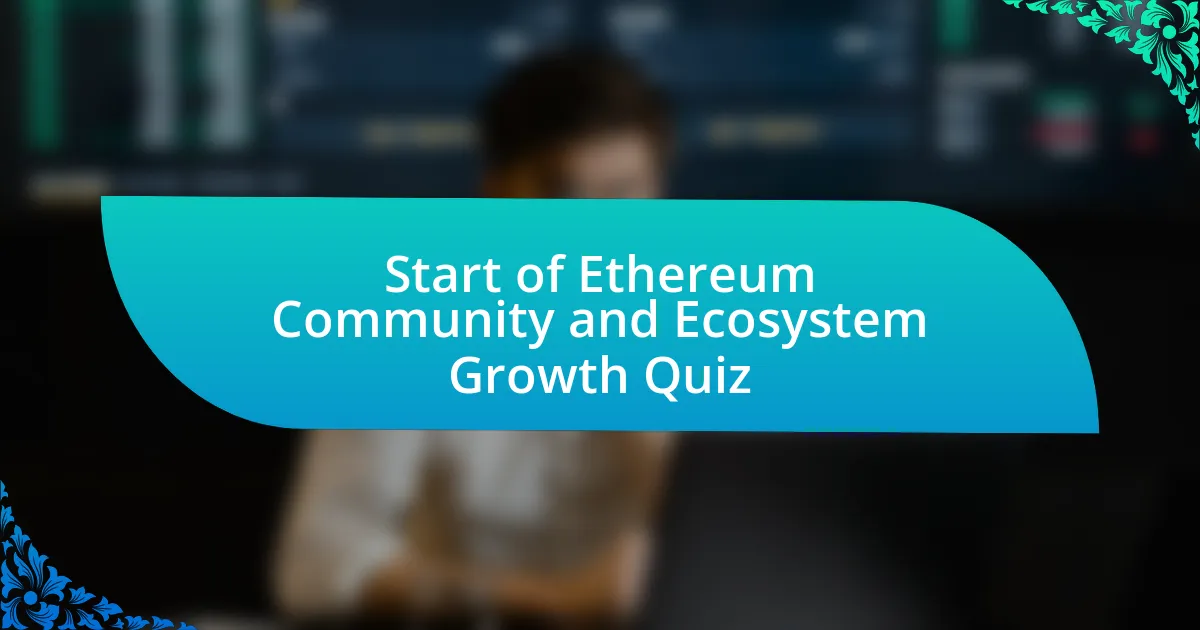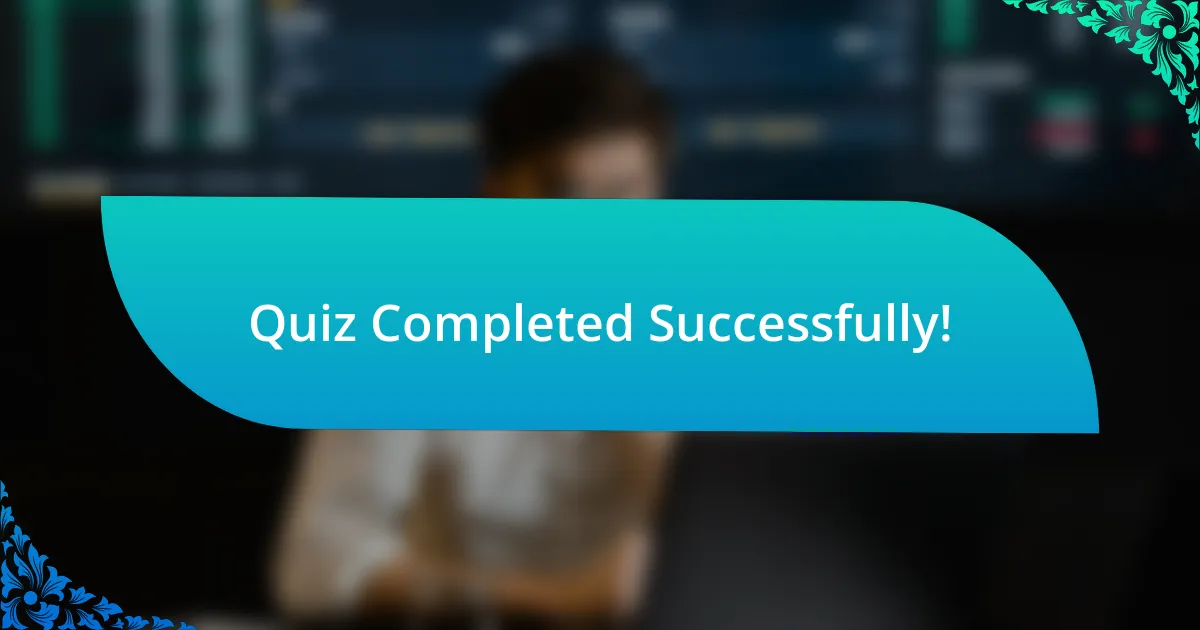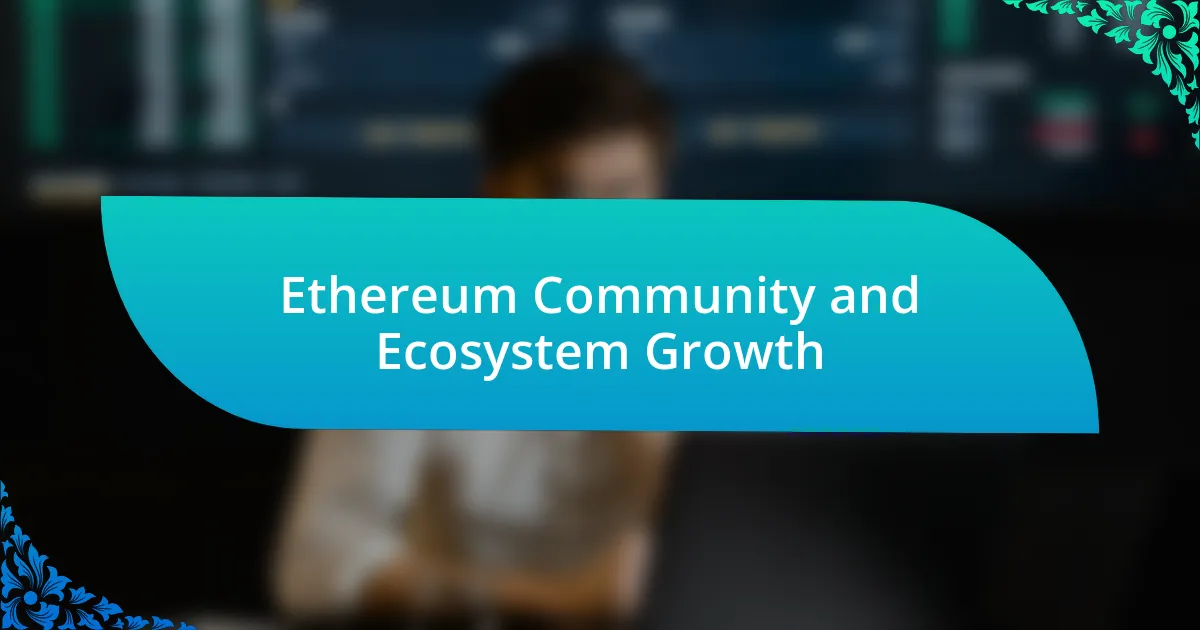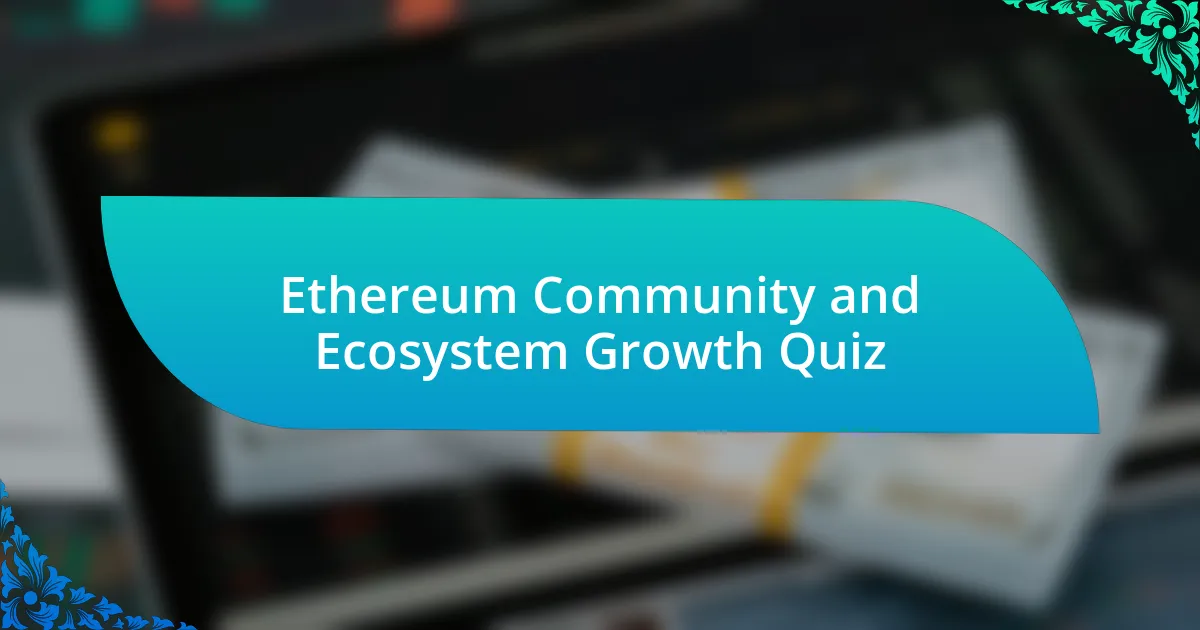
Start of Ethereum Community and Ecosystem Growth Quiz
1. Who are the original authors of Ethereum?
- Vitalik Buterin and Gavin Wood.
- Satoshi Nakamoto and Charles Lee.
- Roger Ver and Cal Evans.
- Brian Armstrong and Jack Dorsey.
2. What is the Ethereum Virtual Machine (EVM)?
- A mobile application for trading Ethereum on smartphones.
- A physical computer that mines Ether for the Ethereum network.
- A centralized database used for transaction storage and management.
- A decentralized virtual machine capable of handling scripts using the public nodes network. It is also Turing complete and utilizes Gas as an internal pricing mechanism.
3. What is the value token for Ethereum?
- Bitcoin (BTC)
- Ether (ETH)
- Litecoin (LTC)
- Dogecoin (DOGE)
4. What is Ether best defined as?
- A crypto-fuel(token) that powers the Ethereum network.
- A type of virtual reality currency.
- A digital asset for online shopping.
- A security for traditional banking.
5. How many Ether is released to nodes that validate a block?
- 2 Ether
- 1 Ether
- 10 Ether
- 5 Ether
6. What is the consensus algorithm used by Ethereum?
- Proof-of-Authority (PoA).
- Practical Byzantine Fault Tolerance (PBFT).
- Delegated Proof-of-Stake (DPoS).
- Proof-of-Work (PoW) transitioning to Proof-of-Stake (PoS).
7. How to mine Ethers?
- Ethers are mined through a mobile application that manages your funds automatically.
- One can mine Ethers by purchasing Bitcoin and converting it.
- One needs to have a wallet and tools such as Geth CLI. With it, you need to participate in the Network and help add transactions to the blocks.
- Ethers are mined using only a basic computer without any special tools.
8. What is a smart contract use case?
- It can be used in social media platforms for sharing posts and updates.
- It can be used in traditional banking for managing savings accounts.
- It can be used in mobile applications for enhancing gaming experiences.
- It can be used in real estate where a seller can set up a smart contract to sell property. The property can be transferred to the buyer once he transfers the property amount.
9. What is MetaMask?
- A standalone desktop application for managing Bitcoin.
- A hardware wallet designed for offline storage of Ethereum.
- A popular browser-based Ethereum wallet that can be used to interact with the dApps on the Ethereum network.
- A social media platform for cryptocurrency discussions.
10. What programming language is used to write smart contracts and dApps?
- C++
- Solidity
- JavaScript
- Python
11. What is Truffle?
- A popular testing and development environment for Ethereum.
- A software for computer graphics rendering.
- A type of gourmet chocolate dessert.
- A species of mushroom used in cooking.
12. What is the block time in Ethereum?
- 20 seconds
- 30 seconds
- 10 seconds
- 14 seconds
13. Is a transaction on Ethereum public?
- Yes, only some transactions are public.
- Yes, all transactions are public.
- No, all transactions are private.
- No, transactions are partially public.
14. Is the user’s private key used to sign transactions?
- Sometimes.
- Yes.
- No.
- Only for receipts.
15. How does Bitcoin differ from Ethereum in checking the latest state?
- Bitcoin relies on proof-of-stake for state validation, while Ethereum uses proof-of-work.
- Bitcoin checks unspent transaction outputs (UTXO), while Ethereum checks the account balance.
- Bitcoin validates blocks using smart contracts, while Ethereum does not.
- Bitcoin uses account-based storage, while Ethereum tracks transactions per block.
16. What happens when the gas runs out without the transaction being complete?
- The balance is automatically adjusted to reflect the change.
- The pending transaction remains in the mempool.
- All the state changes are reversed. The used Ethereum Gas is given to the miner.
- The transaction is completed and fees are refunded.
17. How has the number of unique addresses on the Ethereum network changed since January 2020?
- The total unique addresses have increased to just above 150M.
- The total unique addresses have decreased to under 50M.
- The number of unique addresses has remained unchanged around 100M.
- The total number of unique addresses has more than doubled to over 200M.
18. How many active Ethereum addresses are there currently?
- Below 200K
- Less than 300K
- Around 1 Million
- Above 504K
19. How has the number of daily active users in the Ethereum ecosystem changed since Q1 2020?
- The number has surged nearly nine times to around 2.25 million.
- The number has remained steady at 1 million.
- The number has fluctuated between 500,000 and 1 million.
- The number has decreased to under 500,000.
20. What are the layer-2 networks launched in recent years?
- Monero, EOS, and Cardano
- Litecoin, Dash, and Tron
- Optimism, Base, and zkSync
- Ripple, Stellar, and Blockstack
21. How many active users were on Ethereum mainnet in Q1 2024?
- 250,000
- 500,000
- 378,000
- 1 million
22. How many active users were on Polygon in Q1 2024?
- 500,000
- 3.5 million
- 2.1 million
- 1.3 million
23. How many active users were on the four layer-2 networks combined in Q1 2024?
- 2.1 million
- Around 1.5 million
- 800,000
- 3.5 million
24. What is the forecasted price of Ether by 2030 according to VanEck?
- $5,000
- $50,000
- $10,000
- $22,000
25. What is the current price of Ether?
- $5,000
- $2,500
- $3,862
- $1,000
26. How has the revenue per user of Ethereum compared to Web2 businesses?
- It exceeds most Web2 businesses.
- It matches exactly with traditional retail businesses.
- It is lower than many Web2 companies.
- It varies unpredictably compared to Web2 platforms.
27. What is the expected free cash flow generated by Ethereum by 2030?
- $66B
- $150B
- $10B
- $500B
28. Why do analysts expect the launch of spot Ether ETFs to push the price of Ether to a new all-time high?
- It will lead to a decrease in the number of smart contracts being executed on Ethereum.
- It will allow financial advisors and institutional investors to hold this unique asset and benefit from the pricing and liquidity advantages characteristic of ETFs.
- It will result in significant tax penalties for investors on their profits.
- It will restrict trading to a few major exchanges, lowering the overall demand.
29. How does the Ethereum blockchain generate fees compared to layer-2 networks and Solana?
- It generates fewer fees than all layer-2 networks and Solana combined.
- It generates the same fees as Solana but more than layer-2 networks.
- It generates three times more in fees than the top layer-2 networks and Solana combined.
- It generates half the fees of Solana alone compared to layer-2 networks.
30. What is the relevance of development activity for any cryptocurrency?
- Low development activity suggests short-term profits and gains.
- A high value indicates developer commitment, signaling potential longevity.
- Development activity is not relevant for assessing any cryptocurrency.
- It only reflects the market price of the cryptocurrency at any given time.

Quiz Completed Successfully!
Congratulations on completing the quiz on Ethereum Community and Ecosystem Growth! You’ve taken an important step in enhancing your understanding of this dynamic space. Quizzes like these not only test your knowledge but also reveal areas where you can learn more. Many participants discover intriguing aspects about community involvement and ecosystem projects that they may not have been aware of before.
Throughout this quiz, you’ve explored key concepts and developments within the Ethereum ecosystem. From vital community initiatives to major growth drivers, you’ve gained insights into how Ethereum continues to evolve. Understanding these facets can empower you to engage more effectively within the community and contribute to ongoing discussions.
As you continue your journey, we invite you to check the next section on this page about Ethereum Community and Ecosystem Growth. This resource is designed to deepen your knowledge and keep you updated on the latest trends and advancements. Expanding your understanding will surely enhance your experience in this innovative space. Dive in and continue exploring!

Ethereum Community and Ecosystem Growth
Overview of Ethereum Community
The Ethereum community consists of developers, users, investors, and enthusiasts who contribute to the ecosystem. Their collective efforts drive innovation and adoption of Ethereum’s technology. This community is known for its strong collaborative spirit, fostering open-source contributions and knowledge sharing. Events like Devcon and numerous meetups enhance networking and collaborative projects, facilitating growth.
Key Organizations Supporting Ethereum Growth
Numerous organizations play a vital role in the Ethereum ecosystem. The Ethereum Foundation, ConsenSys, and various decentralized autonomous organizations (DAOs) provide funding and resources for development. These entities promote research, education, and tools that support Ethereum projects. Such support helps maintain Ethereum’s position as a leading blockchain platform and stimulates ecosystem growth.
Impact of Ethereum Improvement Proposals (EIPs)
Ethereum Improvement Proposals (EIPs) are crucial for making changes to the Ethereum protocol. They enable developers to propose enhancements and improvements based on community feedback. EIPs drive technical innovation by introducing new features, optimizing performance, and addressing issues. Recent EIPs, like EIP-1559, have transformed transaction fee mechanisms, significantly impacting user experience and network efficiency.
Growth of Decentralized Applications (dApps)
The growth of decentralized applications (dApps) significantly contributes to Ethereum’s ecosystem. Developers leverage Ethereum’s smart contract capabilities to create innovative dApps across various sectors. The rise of DeFi (Decentralized Finance), NFTs (Non-Fungible Tokens), and gaming applications has attracted millions of users. According to reports, over 3,000 dApps currently operate on Ethereum, highlighting robust growth within this domain.
Community Initiatives and Education Programs
Community initiatives and education programs are essential for Ethereum’s ecosystem expansion. Organizations like the Ethereum Foundation support educational efforts, including workshops and online courses. These initiatives empower new developers and users to understand blockchain technology. Programs such as Gitcoin provide funding for projects and incentives for community contributions. This boosts engagement and fosters the skills necessary for sustained growth in the ecosystem.
What is the Ethereum community?
The Ethereum community is a global network of developers, users, and enthusiasts collaborating to promote and enhance the Ethereum blockchain and its ecosystem. This community responds to technological advancements, engages in discussions, shares knowledge, and supports projects built on Ethereum. It consists of forums, social media groups, meetups, and conferences, with a notable presence in platforms like Discord and Reddit, where members often discuss improvements and innovations related to Ethereum.
How has the Ethereum ecosystem grown?
The Ethereum ecosystem has experienced significant growth through an increase in decentralized applications (dApps), the rise of decentralized finance (DeFi), and the expansion of non-fungible tokens (NFTs). Statistics indicate that as of 2023, there are over 3,000 active dApps on the Ethereum network. Moreover, the total value locked in DeFi protocols surpasses $30 billion, illustrating the ecosystem’s robust development and adoption. This expansion is further driven by advancements in Ethereum’s technology, such as the transition to Ethereum 2.0, which promotes scalability and sustainability.
Where can I find resources about the Ethereum community?
Resources about the Ethereum community are accessible through various platforms, including the official Ethereum website, GitHub repositories, and educational platforms like Ethereum Foundation’s documentation. Online forums like Ethereum Stack Exchange and Reddit’s r/ethereum subreddit serve as valuable resources for discussions and problem-solving among community members. Additionally, events like Devcon and local meetups provide opportunities for networking and knowledge sharing.
When did the Ethereum community start to gain momentum?
The Ethereum community began gaining momentum shortly after the Ethereum blockchain launched in July 2015. The initial success came with the rise of smart contracts and initial coin offerings (ICOs) around 2017, which attracted widespread attention. By 2021, the introduction of DeFi projects and NFTs further accelerated community engagement and ecosystem growth, establishing Ethereum as a leading platform in the blockchain space.
Who are key figures in the Ethereum community?
Key figures in the Ethereum community include Vitalik Buterin, co-founder of Ethereum, known for his influential ideas on blockchain technology and governance. Other notable names include Joseph Lubin, who co-founded ConsenSys, a major software company in the ecosystem, and Aya Miyaguchi, the Executive Director of the Ethereum Foundation. These individuals play crucial roles in driving the community forward through innovation and leadership.

